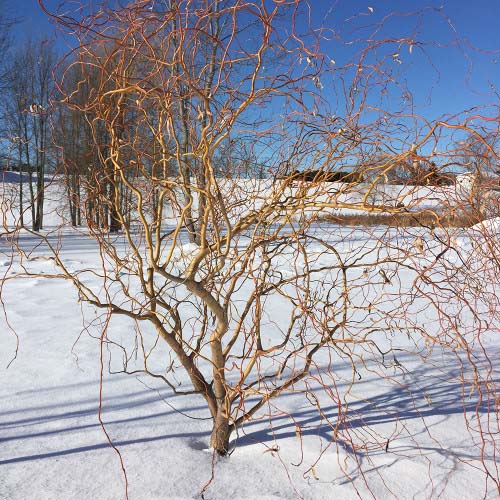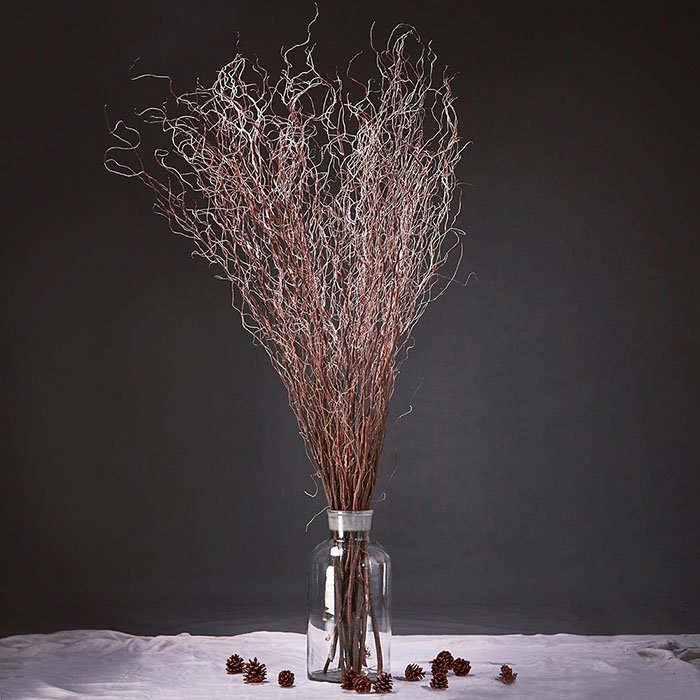Curly Willow specifications
- Common Name : Corkscrew willow, Pekin willow, Hankow willow, twisted-twig willow, contorted willow
- Botanical Name : Salix matsudana ‘Tortuosa’, S. matsudana ‘Koidzumi’
- Family : Salicaceae
- Plant Type : Tree
- Mature Size : 30-40 ft. tall, 15-20 ft. wide
- Sun Exposure : Full, partial
- Soil Type : Loamy, sandy, clay, moist
- Soil pH : Acidic, alkaline
- Bloom Time : Spring
- Flower Color : Yellow, green
- Hardiness Zones : 4-8 (USDA)
- Native Area : Asia
The main appeal of the curly willow are its drooping, twisted, contorted twigs. They start out slender and olive-green in color and mature to gray-brown. Like the twigs, the leaves are often twisted. The bark is gray-brown, with diamond-shaped lenticels when the tree is young. The bark becomes shallowly fissured when mature. The shiny green foliage is simple, alternate, narrow, oval-shaped, and finely serrated.
Fuzzy pale yellow-green flowers ( catkins ) appear in early spring with the leaves. They turn into small light brown fuzzy capsules that contain many small fuzzy seeds. The leaves turn yellow in the fall and once they’ve dropped, the twisted twigs become even more apparent, which lends the tree special winter interest.
read more : Everything about giant reed : How to Plant & care for them

Plant a curly willow any time during the spring or summer. Moist soil and ample space are prerequisites, as it is tall and easily reaches a spread of 20 feet, sometimes even more. It is a fast-growing tree but that comes with a caveat — curly willow is short-lived. Expect to replace it within 15 to 20 years. In ideal conditions it might last 30 years.
Curly willow Care
Like all willows, curly willow needs water to thrive. If the soil isn’t naturally moist, making sure that it gets sufficient water is the most important thing when taking care of the tree.
Apply a two to three-inch layer of mulch a couple of inches away from the base. Mulch will maintain moisture and keep weeds down. A large circle of mulch around the tree not only helps to retain moisture in the soil, it also creates a buffer so you don’t damage the tree when trimming around the tree or mowing the grass, as the the wood is weak and prone to mechanical damage and breakage.
Other than pruning to remove dead branches and ensure good airflow, the tree requires little maintenance.
read more : Everything about stipa : How to Plant & care for them
 Light
Light
The tree is best planted in a sunny location. curly willow prefers full sun, though it will also grow in part shade to part sun.
 Soil
Soil
curly willow isn’t very particular about the soil type; it can grow in clay, loamy, and sandy soil but it must be moist. The tree is equally adapted to a wide pH range, from acidic to alkaline (5.6-7.8).
 Water
Water
While curly willow is more drought-tolerant than other willows, it does have special water needs. To cut down on frequent watering, plant it in a location where the soil is moist most of the time, such as in the lowest part of your garden, where water collects after it rains, or in a rain garden.
 Temperature and Humidity
Temperature and Humidity
Curly willow is a hardy tree that is well-adapted to cold temperatures. It does not fare as well in a hot, humid climate.
read more : Everything about palm : How to Plant & care for them
 Fertilizer
Fertilizer
When planted near or as part of a fertilized lawn, there is usually no need to fertilize the tree, unless the new growth seems weak. One cup of balanced slow-release fertilizer in the spring when the growing season starts is enough to give it a boost.
Varieties of curly willow
There are two willow cultivars with similarly twisted twigs :
- ‘ Golden Curls ’, a naturally occurring cultivar with weeping, twisted golden twigs.
- ‘ Scarlet Curls ‘, a trademarked cultivar with golden twisted twigs that turn scarlet in the winter, as well as curly leaves.
Iran dried curly willow branches
If you want to create a dreamy atmosphere, the use of dried curly willow branches is highly recommended. These dried branches , while beautiful, is completely recyclable in nature and will always look beautiful in your space without being destroyed. The reasonable price of dried curly willow branches has made the sale and purchase of dried curly willow branches a great profit for the wholesalers and exporters of dried curly willow branches .

read more : Drying natural flowers | Introducing 8 wonderful ways to dry flowers
Pruning curly willow
Prune in late winter to early spring. When damaged or dead branches are pruned annually, the tree will stay healthy, let air and sunlight in, and make it less prone to insect damage. dried curly willow
Propagating curly willow
The recommended method to propagate curly willow is from hardwood cuttings when the tree is dormant, after the leaves have fallen in autumn and temperatures are consistently below 32 degrees Fahrenheit at night. Propagation from seeds is not advised, as it won’t produce a tree true to type.
- Take cuttings from the base of a mature tree. The cuttings should be all hardwood with no soft tissue and at least 2 feet long.
- Make a straight cut at the base of the cutting below a bud, and a second, diagonal cut at around 9 inches, above a bud ( you’ll get two cuttings out of one piece ).
- Place cuttings directly into the soil with the straight cut down, about 4 inches deep in the ground. Mark the location well. A more controlled way of rooting the cuttings is to plant them in pots filled with potting mix, also 4 inches deep. Dipping the cuttings in rooting hormone is optional, as willow often roots on its own.
- Keep the soil evenly moist. You should see new shoots in the spring. Let the saplings develop strong roots for at least one growing season before transplanting.
read more : Everything about red willow : How to Plant & care for them
Potting and Repotting
Due it its large size and fast growth rate, the tree is not suitable to be grown in containers.
Overwintering
Curly willow is winter-hardy to USDA zone 4 and does not require any overwintering protection.
Common Pests and Plant Diseases
Curly willow is susceptible to many pests and diseases but they don’t necessarily endanger the tree. The most lasting pests are willow leaf beetles, which go through two generations per year. Adult beetles are metallic blue and eat the whole leaf. The black larvae they leave behind skeletonize the leaves. Typically, willow leaf beetles will not damage all the foliage and the tree will continue to thrive.
Aphids will cause honeydew to appear on lower leaves. Fortunately, predatory insects can deter such pests naturally. If the leaves begin to yellow, this could be a sign of lace bugs. These winged transparent insects are small and found under the leaves, which will turn yellow too early in the season.
Of the fungi that can attack curly willow , powdery mildew is the most widely known. Another fungus is willow scab, which enters twigs and causes cankers, killing young leaves quickly. The fungus can be detected as olive green spores on the underside of leaves. Physalospora miyabeana is another fungus that attacks willow. Yellow spots under the leaves could be a sign of rust, another fungus.
To maintain the tree’s health, prune infected branches as soon as you notice them. Rake up and remove diseased leaves at the end of every growing season to break the disease cycle. dried curly willow
read more : Everything about bulrush plant : How to Plant & care for them
Common Problems with curly willow
The roots of curly willow grow close to the surface and can be quite aggressive. This is important to keep in mind when selecting a planting site. Do not plant the tree near structures, water drainage systems, or pipes.
FAQ
Is corkscrew willow the same as curly willow?
The two are the same. Curly willow is another common name for Salix matsudana.
Where are curly willows native?
The tree is native to China and Korea. ‘Tortuosa’ is a cultivar that was introduced from China to the United States in 1923.
What’s the difference between weeping willow and curly willow ?
Curly willow has an upright growth habit and twisting twigs whereas weeping willow has straight branches that bend downwards.


0 Comments